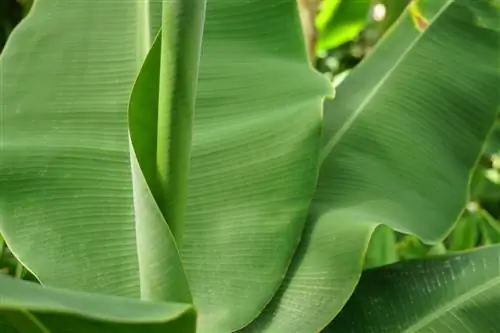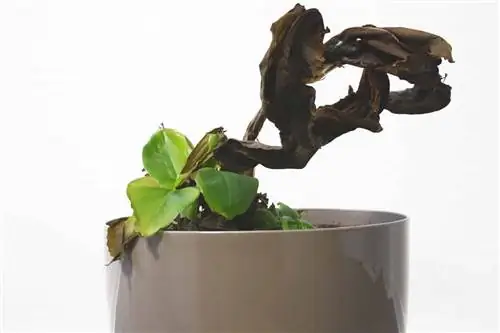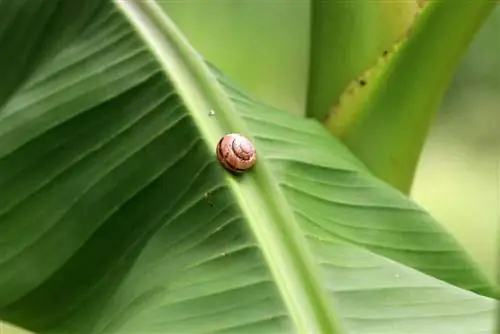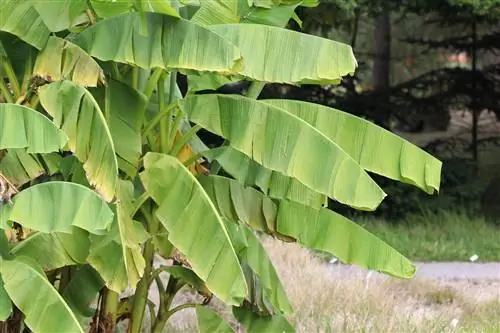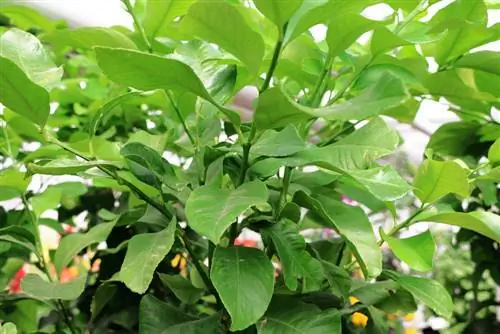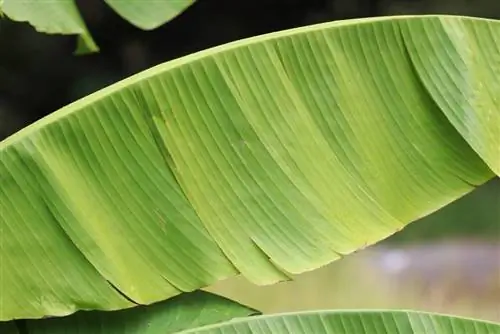- Author admin [email protected].
- Public 2023-12-17 03:39.
- Last modified 2025-01-24 12:45.
Tropical, impressive and decorative, that is the banana tree when it is cultivated as a houseplant or in a winter garden. In summer, the Musa can even be moved outside in the bucket to the terrace, balcony or even into the garden.
Profile
- Origin Tropics in Asia and the Pacific
- bot. Name: Musa
- Banana family (Musaceae)
- around a hundred species known
- cultivated as a houseplant in local latitudes
- May to September also outside in the pot
- Fruits can be eaten
- large and colorful flowers only on old perennials
- Decorative foliage perennial with very large green or red leaves
- growing up to two meters high
Frost-free wintering
The banana tree should definitely be frost-free over the winter. Even though there are now bred varieties that are allowed to spend the winter in the garden in these latitudes, the original banana tree is not winter hardy and therefore requires appropriate care:
- Location bright and cool
- an unheated winter garden is ideal
- alternatively a bright staircase
- Temperatures at least 10° Celsius
- spend to winter quarters in autumn
- Heating air in living spaces harms the plants
- monthly fertilizer applications over the winter
- water less than in summer
- However, never let the soil and root balls dry out
Overwintering in a bucket on the balcony or terrace is only possible in mild regions. In such a case, the pot as well as the entire plant must be protected with a plant fleece. A location in a sheltered corner is ideal.
Note:
Dark overwintering is not ideal, but if no other room is available, it is still possible. In such a case, however, you have to expect leaf loss. The plant remains smaller because it has to produce new leaves again next spring.
High humidity
The banana tree does not require much care, but it is important that there is high humidity, especially indoors in the immediate vicinity of the Musa, so that the decorative leaves do not develop brown edges or tips:
- spray daily with room temperature, decalcified water
- especially important in winter
- dry heating air leads to yellow leaf edges
- place bowls of water around the plant
- alternatively use an electric humidifier
- A table fountain next to the plant looks decorative
- Cultivate banana plants hydroponically
- so water from the pot evaporates upwards
Note:
The water for spraying should be free of limescale, otherwise it leaves unsightly white limescale stains on the large, decorative leaves, which cannot be easily wiped off.
Ideal fertilization
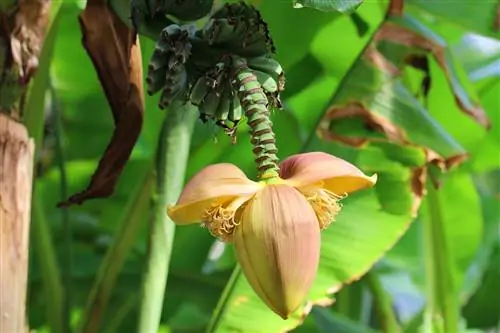
Bananas need to be fertilized regularly so that they can grow quickly and decoratively. When fertilizing, the most important thing to remember is that the root ball must not dry out after application. Otherwise, root damage can occur, which can damage the plant as a whole:
- fertilize from March to October
- once a week
- the chosen fertilizer should be chosen for green plants
- contains all the important nutrients for the banana tree
- also trace elements and vital substances for he althy growth
- pay attention to the manufacturer's instructions when adding quantities
- Add liquid fertilizer weekly with the irrigation water
- alternatively stick fertilizer sticks into the soil
- This is a long-term fertilization for three months
Note:
If your banana tree has light yellow leaves, then the plant is most likely suffering from a lack of nutrients and will need to be fertilized more in the following period. Repotting into fresh, nutrient-rich substrate can also be helpful in such a case,
Is a cut necessary?
Even if the banana tree tolerates pruning well, it usually does not need any pruning:
- Leaves that are too large can be cut off
- also remove old leaves
- Cut is often recommended for reasons of space
- Always cut leaves directly at the base
- use cleaned and disinfected secateurs
- pure alcohol for this is available at the pharmacy
Dedusting regularly
The large leaves of the banana tree also need to be cared for. Because dust can quickly settle on it and should be removed regularly:
- not just a visual problem
- too much dust prevents the absorption of moisture from the air
- so dust with a soft cloth once a week
- carefully move over the leaves
- can tear easily
Proper watering
A banana tree consists mostly of water. Therefore, consistent moisture in the soil is very important for the plant. Temporary drying out or waterlogging is therefore not well tolerated:
- water every day in summer
- at least every two days
- in strong sunlight
- at high temperatures
- immerse small plants once a week
- fill large bucket with water
- Dip plant with pot
- as long as air bubbles rise
- Root ball gets soaked overall
- half an hour later, drain the collecting plate
Tip:
Watering the banana tree depends primarily on the ambient temperature. The cooler it is at the chosen location, the less the plant needs to be watered.
Avoid pests
Unfortunately, there are various pests that like to attack banana plants. It is therefore all the more important to take good care of them so that infestation can be avoided:
Spider mites
- silvery dots on top of leaf
- Webs on the underside of the leaf
- Infestation usually occurs at high temperatures and low humidity
- Wash leaves and care and alternatively change location
Scale insects
- white bumps in leaf axils
- wipe with cloth
- Oils help against infestation
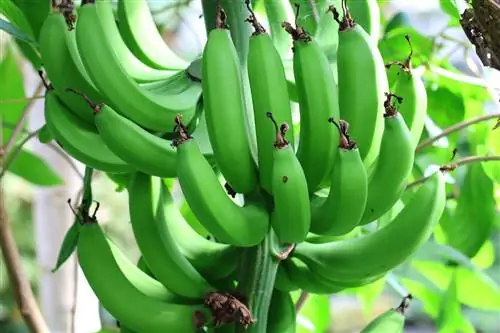
Outdoor or indoor location?
For proper care, the banana tree first needs the right location. This can be chosen in an interior all year round. However, it is also possible for the plant to spend the summer months in a pot on a terrace, a balcony or completely outdoors in the garden:
- bright, warm location in the house
- ideal near a window or balcony/patio door
- Winter garden also well suited
- Avoid drafts
- high humidity should be present
- choose a sunny spot outdoors
- especially older plants need sun
- protected from strong wind by a wall or wall
- Growth is slower in partial shade
- Winter quarters also bright
Tip:
If you put your banana tree outside in spring, you should accustom it to the sun step by step, otherwise unsightly burns can quickly occur on the decorative leaves.
Repotting is important
So that the bananas always have enough space in the bucket, it is important to repot them at least every two years and to choose a larger container for this. Repotting should always be done in spring, when the days get longer again and the light available stimulates growth:
- new vessel about 15 to 20 centimeters larger
- Never plant bananas too deep
- choose potted plant soil as substrate
- A peat-sand mixture with a lot of structure is also recommended
- the moisture must not bind too strongly
- Soil must be permeable
- Create drainage at the bottom of the pot to prevent waterlogging
- Gravel or pottery shards or balls
- above plant fleece
- then fill in soil
Once two thirds of the prepared soil have been filled in, the root ball is placed on top and the remaining soil is filled in. The soil must then be watered well. Before inserting, the root ball can also be immersed in a bucket of water until no more air bubbles appear.
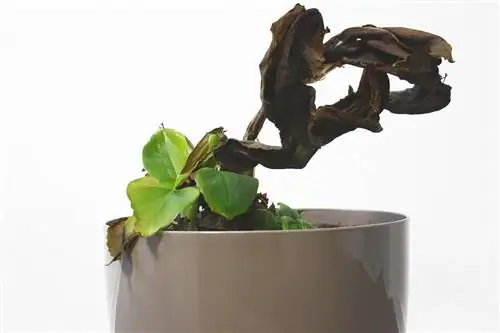
Propagate through offshoots
The banana trees have rhizomes that can be easily divided for propagation. New leaves then quickly sprout from the small piece of root that has been separated. The ideal time for propagation is during repotting, as in this case the root ball is exposed:
- use a clean and disinfected knife
- separate small root parts
- place in small pots with potting soil
- cover with transparent film
- ventilate regularly
- Keep soil moist
- new leaf appears, repot
Note:
You have to be careful when choosing a location for the young plants created from cuttings. Direct sunlight is not recommended in the first year, otherwise the young leaves could quickly burn.

